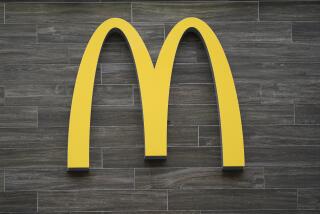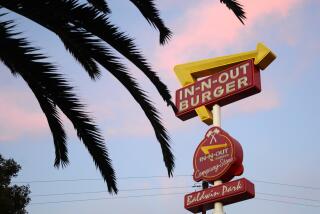One More McTown, but Main St. Retains Special-Order Character
- Share via
COUDERSPORT, Pa. — The day it opened, it seemed as if all Potter County streamed in. Children jostled for Happy Meals. The judge visited the drive-thru (Quarter Pounder, apple pie and Diet Coke, scuttlebutt had it). Downtown merchants sent flowers.
“Now,” said 15-year-old Matt Seeley, “we don’t have to drive 40 miles for a Big Mac anymore.”
On that day last September, two American institutions--one the stuff of tradition, the other the stuff of all-beef patties and sesame-seed buns--converged. On that day, McDonald’s met Main Street.
There are fewer and fewer towns in the land where “Would you like fries with that?” is not a familiar refrain. Until McDonald’s No. 20,160 arrived, with its 57 seats, three outdoor tables and golden-arch architecture scaled down to minimum obtrusiveness, this Allegheny River Valley town of 3,200 souls was one of them.
Coudersport is the sort of unblemished town that late-20th-century Americans dream about, full of mom-and-pop businesses, public spaces and first-name greetings. Until last year, there were two diners, an old-time hotel-restaurant, a few pizza places and three family restaurants, but no national fast-food chains for miles around.
Many Coudersport residents were ready for the McDonald’s that opened on the edge of downtown. It meant a spot on the map. It meant that they were plugged into the modern American goulash of advertising, commerce and popular culture.
It also meant apprehension about what might come next.
*
“Some of the merchants here are deathly afraid of this McDonald’s,” Jeff Kazimer was saying last summer, a few months before the Golden Arches arrived.
Kazimer (one of Coudersport’s two barbers) and five companions were eating lunch in the Crittenden Hotel, considered the borough’s classiest restaurant. But conversation veered to the town’s new eatery.
“Teenagers. All they do is walk the streets here. This’ll give them some self-esteem,” said Shirlee Leete, a writer and state police photographer. “This will give jobs to a lot of people who haven’t been hired in a lot of places.”
Mavis Macklem, who runs Coudersport Insurance, called it “a sign that we’re making progress.
Walter Baker, the president of Coudersport’s Chamber of Commerce and owner of the Crittenden, concurred.
“It’ll bring more people into town,” he said. “That can only be good.”
When McDonald’s came calling, concerns surfaced: Would gaudy signs and car-culture architecture push Coudersport toward garishness? Would traffic be unbearable? Would kids loiter and make trouble, straining the borough’s four police officers?
More ominously, would Burger King, Pizza Hut, even Wal-Mart follow, taking business from downtown? Would Coudersport lose its uniqueness?
“When the first franchise comes to town, it’s generally a wake-up call for the community. People begin to ask: ‘What do we want?’ ” said Kennedy Smith, director of the National Main Street Center, part of the National Trust for Historic Preservation.
“This is exactly the time to look at it,” she said. “In 10 years, when there’s the Pizza Hut and the strip mall out there, it’s simply too late.”
*
Pennsylvania has the nation’s largest rural population; in 1990, 31.1% of its 11.8 million people lived in rural areas, according to the U.S. census. Research by the Center for Rural Pennsylvania tells a familiar story: small-town retailers fleeing to the strip malls, older downtowns struggling, new development in outlying areas.
Many Main Streets have withered or tapered off into netherworlds of chain motels, chain restaurants, chain muffler shops, chain minimarts.
“You can airdrop yourself into some places in the United States and not know where you are,” said Carol Truppi, director of programs for Scenic America, a preservation group.
That may not be desirable, but it is understandable. An estimated 95% of Americans have eaten at McDonald’s, and marketers work so hard to make standardized fast food an integral part of the adscape that consumer-citizens start seeing a gap when it isn’t there.
“Consumerism is the future,” said Bill Caldwell, who just retired as Potter County’s jobs officer. “It’s how we’re going to be tied to each other.”
But the sentiment doesn’t come easy. Self-reliance--especially the culinary variety--is ingrained in this region.
Coudersport, carved from a pine-hemlock forest 192 years ago, has always been defined by the outdoors. Hunting--deer, turkey, grouse, bear--is front-page news. Local histories brim with tales of dinner killed in the woods or pulled from the streams.
Even today, 40% of the county’s homes are hunting cabins, and McDonald’s sits a few yards from the place where Nelson Goodsell caught the county’s largest speckled trout in June 1876.
Those very hunters, though, helped entice McDonald’s. On weekends, they come from all corners of Pennsylvania to camp, hunt, fish and go snowmobiling. Lately, they want modern amenities: Hot tubs are supplanting fireplaces, and elaborate TV-stereo systems are being installed.
And in the morning, they line up at McDonald’s.
Downtown Coudersport, meanwhile, remains strong, and not because of the kitschy gift shops that have reinvigorated so many historic small communities. This Main Street is real; residents use it for daily business. Thus far, aside from a small J.C. Penney, a Sears that closed years ago, several gas stations and a Sheetz convenience store that opened in 1989, virtually all business activity has been independent.
Coudersport once faced the same fate as many of its neighbors: population drift, fading industry, a youth exodus.
But in the mid-1980s, entrepreneur John Regis’ company, Adelphia Cable Communications, began growing rapidly. He kept its headquarters in Coudersport, and Adelphia’s increasing success brought a growing base of skilled labor--today, about 500 jobs--to the region.
Potter County has a vigorous economy. Add that to increased traffic along scenic U.S. Route 6, and McDonald’s--with nearly 60 employees, culled from 150 applicants--seems a natural addition, another indication of Coudersport’s survival.
“McDonald’s knows where to locate,” Truppi said. “If they locate there, it’s probably going to work. And that’s a good indicator for this small town.”
*
Since 1978, Gene Walsh, whose GIW Enterprises is the McDonald’s franchisee in this chunk of Pennsylvania, has dedicated his career to making a national corporation work on a local level. To Walsh, McDonald’s is a family business.
His son, Bob, runs the McDonald’s in Towanda, and his daughter, Debbie, runs the one in Mansfield. GIW also operates the McDonald’s in Wellsboro, a nearby Route 6 town.
“It’s just an amazing company,” said Walsh, a former driver for United Parcel Service. “There’s always somebody who wants to bad-mouth it, but it’s like a family.”
McDonald’s has long encouraged this approach. About 85% of its U.S. stores are franchises, granted to businesspeople who in many cases live in the communities in which their outlets operate.
“Some people saw us as displacing the local mom and pop,” said Chuck Ebeling, a spokesman for McDonald’s Corp. “I think the transformation in 40 years is that we are mom and pop now. We’re not an unknown entity coming to town.”
Walsh, too, while realizing that the Route 6 location is crucial--”We can’t be on a back road and attract just locals,” he said--wants most business to come from the community, not travelers.
He makes a point of buying everything he can locally, from hardware to topsoil. Still, corporate structure limits him. Potter County is famous for its potatoes--a once-giant farm, Potato City USA, is six miles east--but none of McDonald’s fries are made from local crops. They come off a McDonald’s supply truck.
Historically, fast food has inhabited highway strips, interstate exit ramps and edge cities. Now, it is expanding into untapped locales: historic areas, campuses, airports, hospitals--and small-town business districts like Coudersport’s.
“They have to just keep pushing out and getting into these places. It’s where the bodies are,” said Mike Kennedy, an American Express analyst. “They’ll downsize and create on a smaller scale to get new bodies to buy their hamburgers and not somebody else’s.”
*
Ironically, the very things Americans so treasure about Main Street--Victorian and Greek Revival architecture that evokes grand democracy--are themselves the 19th-century version of standardization.
“Years ago, these facades they love so much were being cranked out too,” said Richard Francaviglia, who spent two decades studying small-town business districts for his book “Main Street Revisited.”
“Main Street itself embodies standardization and the whole concept of assimilation into a nationally held system of beliefs and values.”
Today, those values often include the corporate brand names that are just now making their way to Coudersport. Borough Manager Marlin Moore said Burger King has expressed interest, Pizza Hut has poked around, and the Super 8 motel chain has looked at property on the edge of town.
And then there’s Wal-Mart. The discount heavyweight once took an option on property near here, but it never built a store, Moore said. But if a Wal-Mart ever does open, Jack Halloran says he’ll simply close Halloran Hardware.
“This is a town of generations, of businesses passed on,” said Linda Russell, who works at Hauber’s Jewelers on Main Street. “And all of a sudden, up shows McDonald’s and Sheetz, and it’s a very visual reminder that those days you so loved aren’t there anymore.”
So the people of Coudersport are wary, and perhaps rightly so.
“There is no place in America today that will remain special by accident,” said Edward McMahon, director of the American Greenways Program at the Conservation Fund, a nonprofit organization.
“Without exception, the places that are considered outstanding have taken charge of their destiny,” he said. “If Coudersport does nothing, in 10 years, there will be seven fast-food restaurants, and the whole place will go down the tubes. They have to say: ‘We want to stand out.’ ”
*
On a cold February morning, months after the McDonald’s came to town, Jack Halloran arrived at his hardware store with a steaming cup of coffee. Underneath the Crittenden, barber Jeff Kazimer was bibbing up the day’s first trim.
At Mickey’s Diner, Shirlee Leete took a seat and lighted the first in a succession of Misty Menthols. Behind her, the police chief sipped coffee. An acquaintance returned a dime borrowed for parking.
The tables were full, and Leete knew each occupant. The omelets, jammed with fresh stuff, spilled over plates, and no two were the same shape. “Curb your tongue,” warned a sign, “or you might be tonguing the curb.”
Finally, there was 78-year-old Mickey Goodwin herself, who for three decades has risen at 4 a.m., made doughnuts and taken no guff--and who has never set foot in McDonald’s.
“Regulars are very loyal,” said her daughter, Nancy Giannone. “McDonald’s is affecting everyone a little bit, but they’ll always come in for Mom’s fry cakes and glazed Danish.”
Meanwhile, at McDonald’s, people were queueing up for Egg McMuffins, where the eggs fit the McMuffins perfectly, and there is no ordering “the usual.”
“At McDonald’s,” lamented Halloran, “the cook doesn’t come out and talk to you.”
McDonald’s will always be clean, quick, and--with a few regional variations--the same. Main Street may not be so unchanging; the arrival of the fast-food behemoth could signal the start of a civic deathwatch.
Then again, maybe not.
“You see a lot of towns die. Somehow, Coudersport hangs on,” said Caldwell, the retired jobs officer. “Diversity has been the lifeblood of the town. If something fell through, there was something else to fall back on. And I think this is an evolution--something a little more diverse that might help us hang on a little bit longer.”
More to Read
Sign up for Essential California
The most important California stories and recommendations in your inbox every morning.
You may occasionally receive promotional content from the Los Angeles Times.













